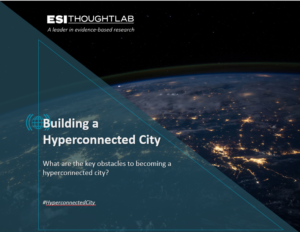The ESI ThoughtLab research coalition has unveiled preliminary findings from its 2019 Smart City Research Initiative, which shows that ‘hyperconnected cities’ generate demonstrable ROI (Return On Investment) for their economies, while providing enormous improvements in living and business conditions.
The ‘Building a Hyperconnected City’ study of 100 worldwide metropolitan centers found that most cities are seeing major economic, financial, and social benefits from their investments in smart technologies, but also greater cyber-risks, if digital innovation is not managed properly. According to the study, 38% of cities deploying smart mobility solutions are bolstering customer satisfaction and 32% are improving productivity and delivery times for business. Likewise, 45% of cities deploying smart environmental and energy initiatives are improving citizen health, 44% are reducing pollution, and 43% are stabilizing energy prices.
The speed of technological change has been brisk. Public WiFi, Internet-of-Things (IoT), cloud computing, and mobile technology are now pervasive across cities, used by more than 90% of them in the study. Other commonly used technologies include biometrics (83% of cities), AI (82%), and Blockchain (66%). Robots and drones, 5G, augmented reality, and distributed computing are promising new technologies, which are still in earlier stages of investment. By using these technologies to transform and interconnect their urban ecosystem, government leaders aim to deliver a myriad of benefits to their stakeholders.
Except for predictive policing, all 62 smart city initiatives studied showed positive investment returns, with the largest gains including:
Mobility and transportation – curb management (4.5%), congestion charging (4.3%);
Energy and water – dynamic electricity pricing (4.8%), renewable energy (4.3%);
Environment – optimizing waste collection (4.1%), real-time water quality monitoring (3.9%);
Public safety – first aid alerts (5.6%), gunshot sensors (4.8%), real-time crime mapping (4.7%);
Governance – digital business licensing (5%), digital payments (4.6%).
However, if not managed effectively, these smart initiatives can also expose urban areas to higher cybersecurity risks. For cities in the survey, the total cost of cyber loss events over the last year averaged US$3.4m, with 10% suffering losses between US$10m and US$20m. Over half of the cities said that they were not well prepared for cyberattacks. The biggest vulnerabilities cited were financial and payment systems (54% of cities), IT infrastructure and telecoms (51%), and mobility and transportation (40%). To cope with rising cyber risks, 82% of cities plan to increase their cybersecurity budgets next year.
The study was based on a rigorous benchmarking survey conducted over the summer of 2019 by ESI ThoughtLab and a cross-industry coalition of sponsors, including Deloitte, Oracle, Stantec, Pennoni, Eaton Lighting, NTT Group, Nokia, Cognizant, Visa, and Microsoft. The sample consisted of 100 worldwide cities engaged in smart city initiatives. These varied in size from 123,000 to over 24 million residents and represented a range of income levels, regions, and stages of economic development.
Lou Celi, CEO of ESI ThoughtLab and director of the study, said, “Our research shows that hyperconnected cities, ones that use technology to transform and interconnect their urban assets, generate demonstrable ROI for their economies, while providing enormous improvements in living and business conditions.”





